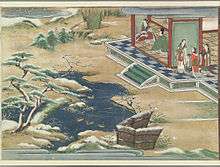Ryūgū-jō
In Japanese folklore, Ryūgū-jō (竜宮城, 龍宮城, "Dragon palace castle") is the undersea palace of Ryūjin, the dragon kami of the sea. Depending on the version of the legend, it is built from red and white coral, or from solid crystal. The inhabitants of the palace were Ryūjin's families and servants, who were denizens of the sea. In some legends, on each of the four sides of the palace it is a different season, and one day in the palace is equal to a century outside its boundaries. The most famous legend about the palace concerns Urashima Tarō's visit to Ryūgū-jō for three days.[1]

Katase-Enoshima Station in Fujisawa, Kanagawa Prefecture, is designed to evoke the feeling of Ryūgū-jō.
In the Ryukyuan religion, Ryūgū-jō (Okinawan: Ruuguu) is the source of fire for all family and village hearths.[2]
See also
References
- ↑ Kawai, Hayao (1995). Dreams, Myths and Fairy Tales in Japan. Daimon. p. 107. ISBN 3-85630-544-0.
- ↑ George H. Kerr, Okinawa: History of an Island People (Tokyo: Charles E. Tuttle Company, 1958), 36.




